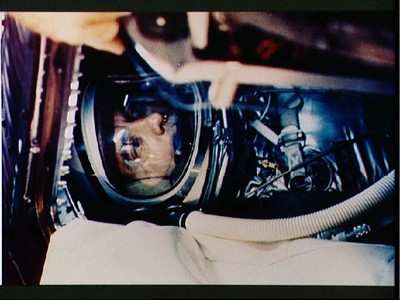Sun, May 08, 2011
Early IBM Analytics Technology Provided Mission Critical Data
In Real-Time
As NASA celebrated the 50th anniversary of the first U.S. manned
spaceflight at an event at the Kennedy Space Center on Thursday,
IBM commemorated its team of mathematicians and technologists who
supported the Project Mercury missions in the 1960s.

"Alan Shepard was the bravest of the brave and his flight
ushered in America's space age," said Professor Arthur Cohen, the
mathematician who led IBM's team that supported Project Mercury.
"The IBM team had the honor of applying computing power and
mathematics to support Project Mercury to provide real-time data to
NASA Mission Control. We experienced an unforgettable sense of
excitement when Alan Shepard safely accomplished his mission. I
will forever remember May 5, 1961 and the incredible team of NASA
and IBM men and women I had the opportunity to work with."
While people around the world were on the edge of their seats on
May 5, 1961, the IBM team was counting on the technology they had
developed to track the spacecraft and provide real-time information
to Mission Control. IBM worked to address the unique data
processing challenges presented by the real-time information
requirements of NASA's Mercury mission.
The team developed a "real-time channel" called the IBM 7281,
which could receive up to 1,000 bits of data per second -- a
breakthrough innovation at the time. They also developed advanced
programs and mathematics to analyze incoming data and provide
"mission critical" information to NASA flight controllers
throughout the space flight for evaluation and necessary action.
Their work represented the early days of real-time and predictive
analytics, which today is a major growth initiative for IBM. Even
then, as it is today, IBM was in the business of making sense of
data.

To provide real-time information to Mission Control, the IBM
team installed and maintained three large-scale computers which
funneled all flight information: two 7090 transistorized computers
located at Goddard Space Flight Center in Greenbelt, Maryland and a
709 computer in Bermuda. The two IBM 7090 computers determined
powered flight trajectory parameters and the present position of
the spacecraft. They predicted future spacecraft position and
transmitted continuous data for display at Mission Control
throughout the flight. The IBM 709 computer calculated normal
orbital flight information in addition to its most important
function -- determining trajectory dynamics during the critical
launch and early orbit phase. The 709 computer analyzed data from
local radar and telemetry sources in real-time.
IBM's work on Project Mercury helped lay the foundation for the
company's work on NASA's Gemini and Apollo space missions and how
businesses and governments exploit data today -- from air traffic
control systems to online travel reservations.
More News
Aero Linx: International Business Aviation Council Ltd IBAC promotes the growth of business aviation, benefiting all sectors of the industry and all regions of the world. As a non->[...]
"During the annual inspection of the B-24 “Diamond Lil” this off-season, we made the determination that 'Lil' needs some new feathers. Due to weathering, the cloth-cove>[...]
Also: Bushcat Woes, Hummingbird 300 SL 4-Seat Heli Kit, Carbon Cub UL The newest Junkers is a faithful recreation that mates a 7-cylinder Verner radial engine to the airframe offer>[...]
Also: Seaplane Pilots Association, Rotax 916’s First Year, Gene Conrad After a decade and a half of struggling with the FAA and other aero-politics, G100UL is in production a>[...]
Also: Martha King Scholarship, Montaer Grows, Textron Updates Pistons, FlySto The FAA is hiring thousands of air traffic controllers, but the window to apply will only be open for >[...]
 ANN's Daily Aero-Linx (04.16.24)
ANN's Daily Aero-Linx (04.16.24) Aero-News: Quote of the Day (04.16.24)
Aero-News: Quote of the Day (04.16.24) Airborne 04.10.24: SnF24!, A50 Heritage Reveal, HeliCycle!, Montaer MC-01
Airborne 04.10.24: SnF24!, A50 Heritage Reveal, HeliCycle!, Montaer MC-01 Airborne 04.12.24: SnF24!, G100UL Is Here, Holy Micro, Plane Tags
Airborne 04.12.24: SnF24!, G100UL Is Here, Holy Micro, Plane Tags Airborne-Flight Training 04.17.24: Feds Need Controllers, Spirit Delay, Redbird
Airborne-Flight Training 04.17.24: Feds Need Controllers, Spirit Delay, Redbird




